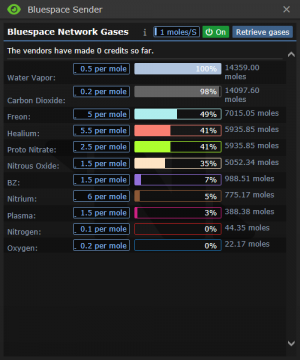Участник:Foomf/Sandbox
Foomf's Basic Guide to the Hypertorus Fusion Reactor[править | править код]
The Hypertorus Fusion Reactor (HFR), otherwise known as the "Danger Donut", is a complicated piece of machinery that likes to explode if you are not careful. The main guide for the HFR can be found here: Guide to the Hypertorus Fusion Reactor. This guide is very thorough and complex. The info in it is good, but it's a bit daunting. This guide serves as a much more gentle onboarding for the HFR. It will get you competent enough to run it without blowing yourself up.
There's going to be a lot of over simplifications and arm waving in this guide. I'm sure someone can say "Ackshually..." to every sentence in here. If you want hard numbers and tons of depth, go read the main HFR guide (linked above). Everything in this guide is covered in more detail in the main guide.
Please Oh God Just Help Me Shut It Down Before It Explodes![править | править код]
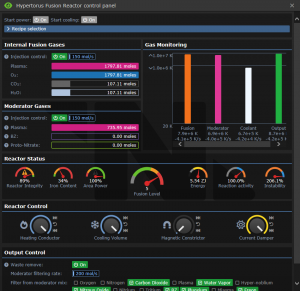
If you have found yourself on this page because you are near an HFR that is in the process of melting down and you want to avoid having a hole in your station, follow this guide of steps from top to bottom:
- Find the person running the HFR. Hopefully they know how to shut it off. If you are the person running the HFR, continue to step 2.
- Make sure the HFR room has enough power. A melting down HFR will draw 350 KW of power. When the HFR loses power, it will lose integrity very fast. If the APC is out of power, hopefully you have an inducer on hand to quickly charge it back up. If you are struggling to keep the HFR powered, turn off any thermo machines that are in the room. Yes, even the ones connected to the coolant.
- Set your HFR dials as shown on the right. Make sure waste removal is turned on and maximized. The dials will reset each time the HFR loses power so make sure to adjust them each time power is restored.
- If there is any proto nitrate in the moderator, filter it out.
- Turn on any thermo machines if you have the power budget for it. At fusion levels of heat, thermo machines will use a significant amount of power.
- Make sure the fuel doesn't exceed ~3500 moles of each type. If you have too much fuel in your reactor, maximize the injection rate to 150 mol/s (and make sure it is off). Getting down to <1500 moles of each fuel type will help you a ton!
- If you are at fusion level 5 or 6, add o2 to the moderator mix.
- If you are at fusion level 5 or 6 and below 50% reactor integrity, add some healium into the moderator mix.
- Make sure the coolant pipe is attached to either thermo machines set to cooling or attached to a space heat exchange loop. Remember, if the area loses power, thermo machines don't turn back on automatically.
- If your fusion mix is still heating up, add some freon to the moderator. If your fusion mix is losing heat, make sure there is no freon in the moderator.
- If the heat is still rising, you're probably using a fuel mix that is much harder to cool. Good luck!
- Run.
- Pray.
- Call the shuttle.
Why Run The HFR?[править | править код]
The purpose of the HFR is to produce rare and interesting gases. Despite being called a "fusion reactor", It does not produce energy! In fact it will consume a lot of energy.
The HFR also has a secondary purpose of being a stable source of high temperatures. This is very useful for some crystallizer recipes, like metal hydrogen.
An Overview Of The HFR Exterior[править | править код]
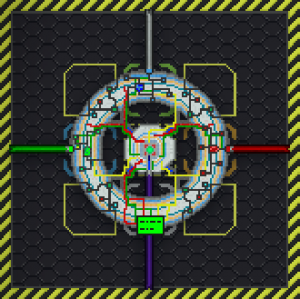
To the right is the HFR itself. The interface is to the south, the fuel input to the west, the moderator input to the north, and the waste output to the east. These can be switched around in whatever way is convenient for you. For instance, the waste output can be to the north, the moderator input to the west, etc. The large lights on the HFR will tell you what each side does:
- Green = Fuel Input
- Blue = Moderator Input
- Red = Waste Output
The coolant will always connect to the center piece from the south. Note that in the image on the right, the coolant line runs under the interface piece.
Fuel Input[править | править код]
This is where you input the fuel mix for the HFR. It is always going to be a 50/50 mix of something. The fuel has an impact on how much heat the reactor produces and what byproducts it makes. This is a one way input: gas only flows into the HFR from this connection.
Moderator Input[править | править код]
This is how you get moderator gas into the HFR. The purpose of the moderator gas will be explained in later section. This is a one way input: gas only flows into the HFR from this connection.
Waste Output[править | править код]
This is where your hard earned gases will come from. This is probably why you are running the HFR! This is a one way gas output: gas only flows out of the HFR from this connection.
Coolant[править | править код]
The coolant is one of the primary ways you will cool down the reactor. This is a two way input/output: gas will flow freely between the connected pipe and the internals of the reactor.
An Overview Of HFR Interface And Concepts[править | править код]
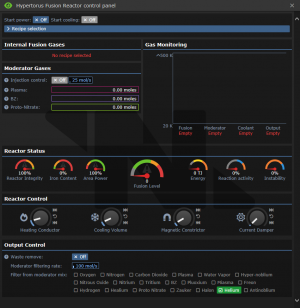
Start Power/Start Cooling[править | править код]
This is how you turn the HFR on and off. I'm sure there's a good reason why they are two separate buttons but I always press them together.
Recipe Selection[править | править код]
This is how you tell the HFR which gases to use for fuel. You can also use it to view all the different fusion mixes available. Inside this drop down menu, click the power button to the left of the fuel mix you want to use.
Internal Fusion Gases[править | править код]
The fuel is what is burning in the HFR to produce heat. Fuel is always a mixture of two different gases. There are a few different fuel mixes to produce, and they have different properties such as heat output, gas byproducts and rates of production. The main guide has a comprehensive list of the fuel mixes: Guide to the Hypertorus Fusion Reactor#Recipes
Once you have selected a recipe, you will be given access to the injection control. This allows you to control how fast gas is added to the HFR and how fast the gas is burned.
I try to have 2000 moles of each gas. If you have too much gas in your fuel, your reactor integrity will instantly drop to 0% and will pop like a balloon. The fuel mix will go in the air around you. Not a good time!
The fuel will get really, really hot. Hotter than the surface of the sun. Your fuel mix can easily go above 10,000,000 kelvin if you are not careful (room temp is 293 kelvin). You will probably be piping in room temperature fuel. At that temperature difference, your fresh fuel is essentially super cooled. This can be a great way to cool down the fuel in your reactor!
Moderator[править | править код]
The moderator has four purposes:
- Heat exchange: The moderator moves heat between the coolant and the fuel. The coolant and moderator exchange heat quickly, while the moderator and fuel exchange heat slowly.
- Gas production: The moderator is what is reacting in the HFR to produce interesting gases. The main guide has a comprehensive list of which gases moderators produce: Guide to the Hypertorus Fusion Reactor#The Moderator mix
- Fusion behavior: Right now the only gas that changes the behavior is Freon. If there is freon in the moderator then the reactor is easier to cool.
- Reactor repair: Right now the only gas that can fix the reactor is Healium. If there is healium in the moderator then the reactor will repair itself at fusion levels 5 and 6 only.
The injection control lets you configure how fast moderator is added to the HFR.
If BZ is in your moderator, you need to wear mesons or you will hallucinate (just like the supermatter crystal). At fusion level 6, mesons will no longer protect you from hallucinations. BZ will also cause particles to emit from the HFR. The only place they won't hit is the tile directly behind the HFR interface.
Reactor Integrity[править | править код]
This dial indicates the "health bar" of your reactor. If this hits 0%, you will no longer have an HFR. You will have a hole in your station and the ire of your crewmates instead.
As long as the HFR is turned on (and fusion level 4 or lower), it will heal itself over time. At fusion levels 5 and 6, Healium will also increase the reactor integrity.
Iron Content[править | править код]
Iron damages the reactor. As this value goes up, your reactor integrity will go down. Iron gets added to the HFR at fusion levels 5 and 6. Iron gets removed from the HFR at fusion levels 4 and lower.
When the HFR loses power, 10% of iron is added per second. This is very bad!
Area Power[править | править код]
This is the reading of the APC of the room the HFR is in. As a rule of thumb, if this is less than 100%, time to shut the HFR down. If the HFR loses power, all of the knobs and buttons get set in a way that optimizes getting the reactor integrity to 0 as fast as possible! The only way to fix this is to restore power to the reactor so that you can change the knobs and buttons back to more sane values.
Fusion Level[править | править код]
The fusion level is directly related to the heat of your fuel. Hotter fuel = higher fusion level. Your fusion level is what decides which kinds of gases you are producing. Moderator gases and the fuel mix produce different things at different fusion levels. The HFR can only be turned off when it is at fusion level 0.
| Fusion Level | Min Temp (K) | Max Temp (K) | Iron Content | Power Use |
|---|---|---|---|---|
| 0 | 0 | 500 | Removes Iron | 50 KW |
| 1 | 500 | 1,000 (1e+3) | Removes Iron | 100 KW |
| 2 | 1,000 (1e+3) | 10,000 (1e+4) | Removes Iron | 150 KW |
| 3 | 10,000 (1e+4) | 100,000 (1e+5) | Removes Iron | 200 KW |
| 4 | 100,000 (1e+5) | 1,000,000 (1e+6) | Removes Iron | 250 KW |
| 5 | 1,000,000 (1e+6) | 10,000,000 (1e+7) | Adds Iron | 300 KW |
| 6 | 10,000,000 (1e+7) | No Max | Adds Iron | 350 KW |
Instability[править | править код]
When the fuel reacts, it produces heat. When the reaction is unstable, it loses heat instead. An unstable reaction cools down which is a great way to lower your fusion level. This is directly impacted by the current damper (see below). If the reaction is unstable, the moderator will no longer produce interesting gases!
Instability is a binary concept. The reaction is either stable or not.
Heating Conductor[править | править код]
The heating conductor controls how fast the HFR's fuel temperature changes. A high heating conductor value makes the fuel get hot very fast. If the reaction is unstable, a high heating conductor value makes the fuel cool down very fast.
Cooling Volume[править | править код]
The cooling volume dial controls how much coolant is inside the reactor. I turn this up when I want the coolant to have a greater impact on fuel temperatures.
Coolant is the main way to exchange heat between the HFR and the outside world. You want to choose a gas with a high heat capacity (see: Guide to Atmospherics#Physical Characteristics of Gases). Plasma is an easy choice for the coolant. The only gases with a higher heat capacity is Zauker, Freon, and Hypernoblium. I always use plasma.
Magnetic Constrictor[править | править код]
I never touch this dial and always keep it minimized.
Current Damper[править | править код]
Minimize this to make the reaction stable. Maximize it to make the reaction unstable.
I don't know why this is a dial. You will only have it maximized or minimized (like I mentioned earlier, the reaction is either stable or not). No in-between.
Waste Removal[править | править код]
Turn this on to output your reaction byproducts (waste) from the HFR. This will NOT remove your fuel.
Moderator Filtering Rate[править | править код]
I almost always have this maximized. This is how fast your waste gases are removed from the HFR.
Filter From Moderator Mix[править | править код]
This lets you choose which gases to remove from your moderator mix. The fewer filters you have selected, the faster the filters will work.
The Basic Setup[править | править код]
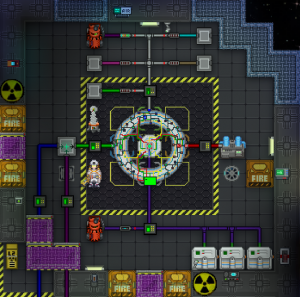
This is a basic HFR setup. It should not take too long to make, and will keep you safe for the basic plasma/oxygen fuel mix. No guarantees that this setup will work for other fuel mixes!
Fuel Input[править | править код]
Connect this to a gas mixer that mixes 50% plasma and 50% oxygen. It is important that both gases are the same temperature so that the gas mixer mixes as expected.
You always want these hooked up to their respective main gas tanks in atmospherics. This way you can flood the HFR with fresh fuel to cool it down in a hurry.
Moderator Input[править | править код]
There are only 5 moderators you are going to be using (plasma, bz, proto-nitrate, freon, healium), so I like to make a connector for each of them. 99% of the time I only use plasma and bz in my moderator, but I added all 5 connectors here for completion's sake.
Waste Output[править | править код]
The omni bluespace gas sender is incredible. It is a bottomless gas tank that accepts gases at any temperature. Even better, when you output gases from them, they are at room temperature! No need to worry about cooling down the output gases (which will be very hot).
Coolant[править | править код]
I fill the coolant pipe with as much plasma as I can. After that, the plasma canister is no longer needed. The coolant is going to get extremely hot while the HFR is running so you will have no hope of adding any more coolant once it is turned on anyways.
Three thermo-machines are enough to easily control a plasma/o2 fuel mix. Having them upgraded is nice but not critical to running the HFR. You can run it with T1 thermomachines if you want to. The better cooling, the faster you can produce interesting gases with the HFR.
You also need the thermomachines to quickly get yourself to fusion level 1 (by putting them in heating mode so you can quickly cross that 500 kelvin threshold).
Grounding Rod[править | править код]
If the HFR is melting down, it will start arcing lightning. When you're trying to get things under control, the last thing you want is to be constantly zapped (and possibly killed)!
Holofan Over APC/Doors[править | править код]
It is important to stress just how devastating losing power is to the HFR. This APC must be protected at all costs. One of the best things you can do is place a holo fan in front of it. If the HFR room becomes an inferno, this one holo fan will prevent the APC from getting destroyed. When the HFR is melting down, you do NOT want to be fumbling around with rebuilding the APC.
There are two main ways you can accidentally cause your HFR room to become an inferno that is not caused by the HFR itself exploding:
- You put too much fuel in the HFR. If the HFR gets too much fuel, it "pops" and the fuel spills out everywhere, and then probably ignites.
- You had a canister connected to the waste output or coolant line and forgot to turn on the shielding. Canisters will explode in an instant and spill their contents due to the insane pressures and temperatures the waste output pipe and the coolant output pipe can reach.
The door holofans are simply to prevent your HFR room inferno from ruining the rest of your atmospherics department's day. One less thing to think about when you are fire and the only thought going through your head is RUN.
Checklist[править | править код]
Here is a checklist that you should follow before turning on the HFR.
▢ Power grid has at least 350 KW excess? The HFR will use this much power so it is very important that you have this headroom.
▢ APC upgraded with bluespace power cell? The larger the power cell, the more time you will have to turn the HFR off when your room starts losing power.
▢ Inducer with bluespace power cell? If your APC does lose power, an inducer can you back up and running in a pinch.
▢ Holofans placed? Every HFR room comes with at least one holofan projector in it. I always use one to place the holofans, then place the projector in my emergency box.
▢ Grounding rod built? Hopefully you never need it, but if you do need it, it is invaluable.
▢ Coolant added to cooling pipes?
▢ Omni bluespace gas sender turned on and maximized? By default it is turned off. You need to turn it on and max the gas input.
▢ Does the rest of Engineering know? At least a heads up is appreciated so that engineering can monitor power. Nobody likes to be blindsided by a melting down HFR that they didn't know even existed. It will announce its integrity levels falling over comms.
▢ APC at 100% charge? If your APC is not charging, do not even consider turning on the HFR.
▢ Radiation protection? The HFR produces A LOT of radiation. Radiation protection is a must!
▢ Meson goggles? This is only needed if you plan on using BZ in the moderator mix.
▢ Are you safe? Odds are you're going to be the only one who knows how to run the HFR. If you are incapacitated, don't expect your crewmates to know how to turn it off.
Your First HFR Run[править | править код]
Minimize Dials[править | править код]
Minimize the heating conductor, magnetic constrictor and current damper.
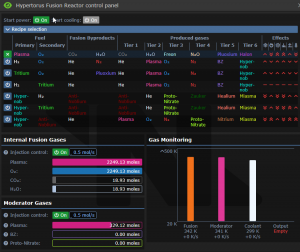
Start Power[править | править код]
The first thing you want to do is turn on the HFR. This is the start power button and start cooling button on the top.
Select Recipe[править | править код]
Next, select your recipe. In this guide we are using plasma and oxygen.
Fueling[править | править код]
Turn on the injection control until you have 2000 moles of plasma and 2000 moles of oxygen. After that, minimize fuel injection.
Add Moderator[править | править код]
Turn on the moderator injection control. I usually keep it at something low like 300-600 moles. After that, minimize moderator injection.
Enable Waste Removal[править | править код]
Simply click the button to turn it on. Don't forget to max the moderator filtering rate as well.
Pre-Heating[править | править код]
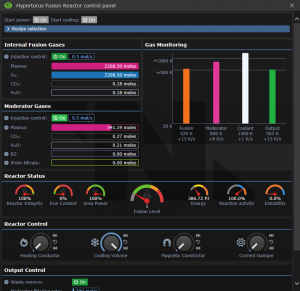
At first, your fuel will be at room temperature. You need to get it above 500 kelvin to start the fusion reaction. You can do this by maxing the heat of your thermo machines and maximizing your cooling volume.
As you can see on the right, we've hit fusion level 1 because we are above 500 kelvin. We also got some CO2 and H2O in our moderator mix. We don't want those there, so let's enable carbon dioxide and water vapor in the waste removal filters at the bottom. As other stuff shows up in the moderator that you don't want, you should enable the filter to get rid of them. Gases filtered out will be sent out the red pipe and into our omni bluespace gas sender.
Notice below the fusion bar, it says +13 K/s. Our fuel mix is gaining 13 kelvins per second. It is heating up.
Heating[править | править код]
Now that we are at fusion level 1, we can let fusion take over and let the mix heat up on its own. You need to be very careful at this step. This is where most HFRs get out of control and melt down.
Minimize the cooling volume and set the thermo machines to cooling mode, minimizing their target temperature.
Let's aim for fusion level 3. This will give you room for error if you accidentally get into 4. When you're actually running the HFR to produce gasses, you will want to stay in fusion level 4.
Maximize the heating conductor until your fusion is at the temperature you want. Note that after you cross each fusion level, the fusion mix heats up significantly faster than before. This can easily catch you off guard! The gas monitoring panel has horizontal bars that show you when you will hit your next fusion level.
Once you are at fusion level 3, minimize the heating conductor again.
Cooling[править | править код]
Now that the HFR is at fusion level 3, let's cool it down. Once we are at fusion level 0 we can shut off the HFR.
There are three main ways to cool down the HFR:
- Increase Fuel Injection Rate: You're at fusion level three, which means your fusion mix is somewhere between 10,000 and 100,000 kelvin. Room temperature is 293 kelvin, which is basically supercooled. Go ahead and turn up the injection control to 150 mol/s. Your temperature will rapidly decrease. Careful not to put too much fuel in the reactor or it will explode!
- Maximize the Current Damper: This will make the reaction unstable, and it will start losing heat. For demonstration purposes, minimize your injection control and then maximize your current damper. Your temperature will start to go down. Having the heating conductor minimized and the current damper maximized is a great configuration to have your HFR in if you need to leave it unattended for a little bit. While your current damper is minimized, go ahead and maximize the heating conductor. You will notice your temp will go down even faster.
- Maximize the Cooling Volume: This lets the coolant do more heat transfer in your HFR. Your coolant can now do its job of cooling down the reactor. For demonstration purposes, minimize your heating conductor and your current damper. Then, maximize your cooling volume. Assuming your thermo machines are turned on and set to cooling, your reactor's temperature will start to go down.
We can do all three of these things at once. To cool down the reactor in a hurry, lets increase our fuel injection control, maximize our current damper, maximize our heating conductor, and maximize our cooling volume. Our reactor will start cooling down very fast.
Turning Off The HFR[править | править код]
Once you are back down to fusion level 0, turn off the moderator injection control, the fuel injection control, and then press the two power buttons at the very top of the control panel. Congratulations, you ran the HFR and you turned it off! If you look at the omni bluespace gas sender, you will see the goodies you made. Not much, probably. In the next section we will work on optimizing gas production.
Optimizing Gas Production[править | править код]
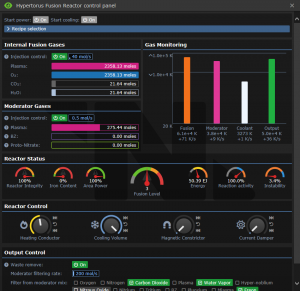
To produce lots of interesting gases, you will need a high injection control and a high heating conductor value. I don't know the exact math formula, but having both of these at a non-minimized state will get you producing a large amount of gas.
Remember, the HFR only produces gases if the reaction is stable. You must keep your current damper minimized!
As we know, raising the heating conductor makes the fusion reactor heat up more. since we can't use the current damper to cool down the HFR without also killing our gas production, that only leaves us with two ways of managing heat: fuel injection and coolant.
Thankfully, the fuel injection needs to be raised anyways to produce gases. Our goal is to balance the heating conductor, fuel injection rate and cooling volume to maximize gas production while keeping the HFR fusion temperature steady. We also don't want to produce so much byproduct that it overwhelms our filters and starts to accumulate in the HFR itself.
Here's an example of a configuration I have where I'm producing a good amount of gases at fusion level 3. This is just for demonstration. Fusion level 3 with plasma doesn't produce all that much.
BZ produces most of the interesting gases that you will care about. BZ only does interesting things at fusion level 3 and 4. I like to use plasma to get through fusion levels 0-3, then filter out all the plasma from the moderator and replace it with BZ for fusion levels 3 and 4. I then get myself steady at fusion level 4 and let it run for a while.
